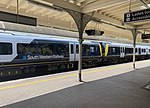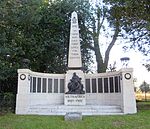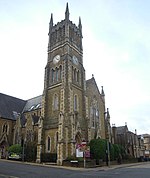Aldershot
1086 establishments in EnglandAldershotMilitary in HampshireOlympic equestrian venuesPopulated places established in the 11th century ... and 6 more
RushmoorTowns in HampshireTowns with cathedrals in the United KingdomUnparished areas in HampshireUse British English from June 2014Venues of the 1948 Summer Olympics

Aldershot () is a town in Hampshire, England. It lies on heathland in the extreme northeast corner of the county, 31 mi (50 km) southwest of London. The area is administered by Rushmoor Borough Council. The town has a population of 37,131, while the Aldershot Urban Area, a loose conurbation (which also includes other towns such as Camberley, Farnborough, and Farnham) has a population of 243,344, making it the thirtieth-largest urban area in the UK.Aldershot is known as the "Home of the British Army", a connection which led to its rapid growth from a small village to a Victorian town.
Excerpt from the Wikipedia article Aldershot (License: CC BY-SA 3.0, Authors, Images).Aldershot
Station Road, Rushmoor
Geographical coordinates (GPS) Address Phone number Website Nearby Places Show on map
Geographical coordinates (GPS)
| Latitude | Longitude |
|---|---|
| N 51.248333333333 ° | E -0.76138888888889 ° |
Address
Royal Mail
Station Road 48
GU11 1AA Rushmoor
England, United Kingdom
Open on Google Maps










